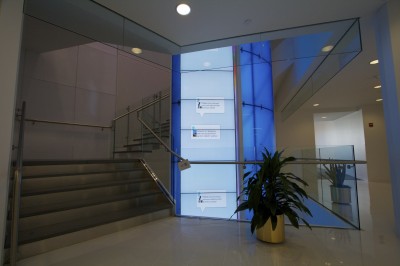Image interruptions
With regard to the displayed content, software is also providing more options for dealing with the ‘seams’ in video walls. While LCD and plasma display manufacturers have reduced their bezels to as thin as 2 to 5 mm (0.08 to 0.2 in.), they still inherently cause interruptions in a wall-sized image.
So, one option is to enable ‘bezel compensation,’ which hides enough of the image’s pixels to maintain linearity across the screens, which is usually desirable for photos, artwork and video.
“Video wall software can compensate for the bezels with black ‘gutters’ between the facets of the image,” Greenberg explains.
Alternatively, bezel compensation can be disabled to ensure no content is obscured. Linearity is lost, but all pixels are visible, which is usually important when displaying text, charts and maps.
A third option, of course, is to use the aforementioned rear-projection cubes for a more seamless appearance. This way, a video wall can be built with less than 1 mm (0.04 in.) of bezel space between its facets.

Due to their dedicated software, they can display a combination of still images, high-definition (HD) video and live data feeds that would otherwise be prohibitively complex.
Screen calibration
Displays should also be calibrated for colour and brightness. ‘Edge compensation,’ for example, levels out the brightness that would otherwise fall off at the bezels where screens meet. This helps produce more uniform images across the entire video wall.
Another type of screen calibration comes during hardware installation.
“You need a mounting system that can provide sufficient structural strength along a flat surface,” says Greenberg. “There are mounts made specifically for video walls today, with mechanisms that ensure the screens are properly aligned and spaced. They are adjustable and modular.”
In some instances, however, despite the flexibility of multi-tile configurations, a projection will work better.
“While video walls provide many advantages, projectors can do what video walls can’t,” says Brawn. “They can work on curved surfaces, avoid bezels and enable very large images.”
Enabling interactivity
Some video walls are even being made interactive, reflecting the public’s growing familiarity with touch screens and gesture-based systems—but this entails a whole new set of technical issues.

One of the challenges with many video walls is how to mount them in an existing architectural space. New modular hardware for this purpose is easier and faster to install, enabling adjustments to be made where needed.
“With interactivity, the person is standing right in front of the wall,” says Brawn, “so you need not only the ability to support touch or gestures, but also sufficient pixel density for image clarity at a shorter viewing distance—along with a more comfortable temperature, given LCDs and plasma screens both emit heat from the front. Some flat panels are now specially designed to vent heat out the back instead.”
Another issue is the user’s eye comfort when looking at a screen at arm’s length. Special coatings will help optimize the colour temperature and focus for the viewer. While anti-glare coatings can cause image ‘speckle,’ diffusion and glossy screens tend not to do so. Rear-projection cubes, by the nature of their design, are also not as harsh to look at up close.
Along with coatings, touch-screen overlays can be added to standard LCDs to make them interactive. While this technology is common today, however, a fully touch-enabled video wall is not a simple matter.
As integrators become more creative, however, more immersive video walls will become part of the built landscape. Software will allow more complicated content to be handled in a user-friendlier fashion with less expensive processors—and then sent wirelessly to more energy-efficient, eye-pleasing screens.
With files from Brawn Consulting, Hiperwall, NEC Display Solutions, Christie, the Digital Signage Expo (DSE) and the Digital Signage Federation (DSF). For more information, visit www.brawnconsulting.com, www.hiperwall.com, www.necdisplay.com, www.christiedigital.com, www.digitalsignageexpo.net and www.digitalsignagefederation.org.
To read the sidebar, 10 Steps to Video Wall Success, click here.





